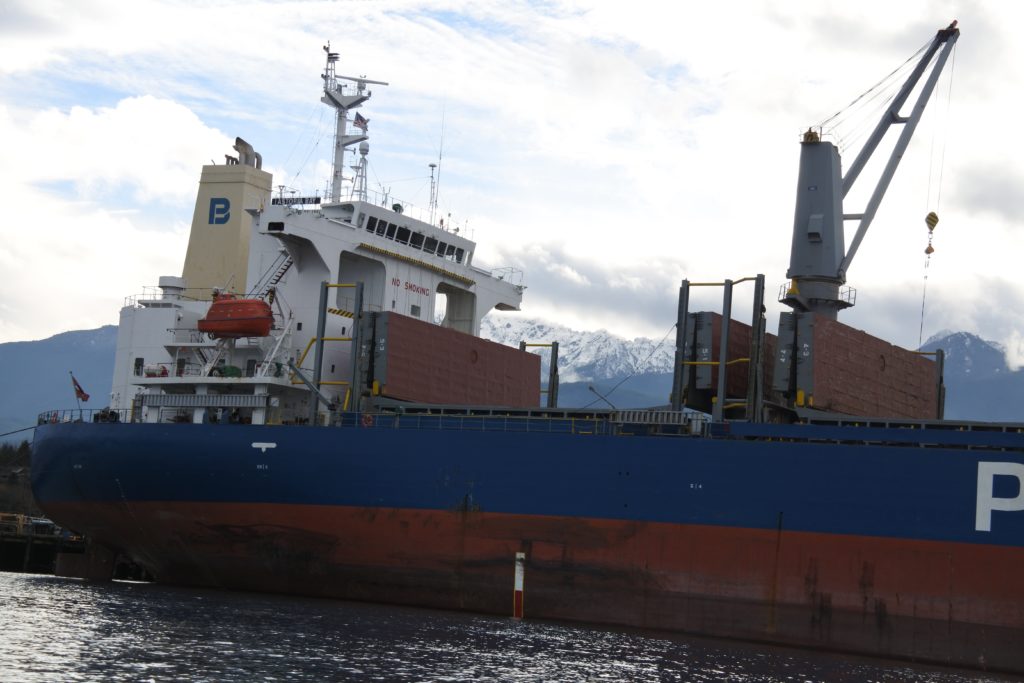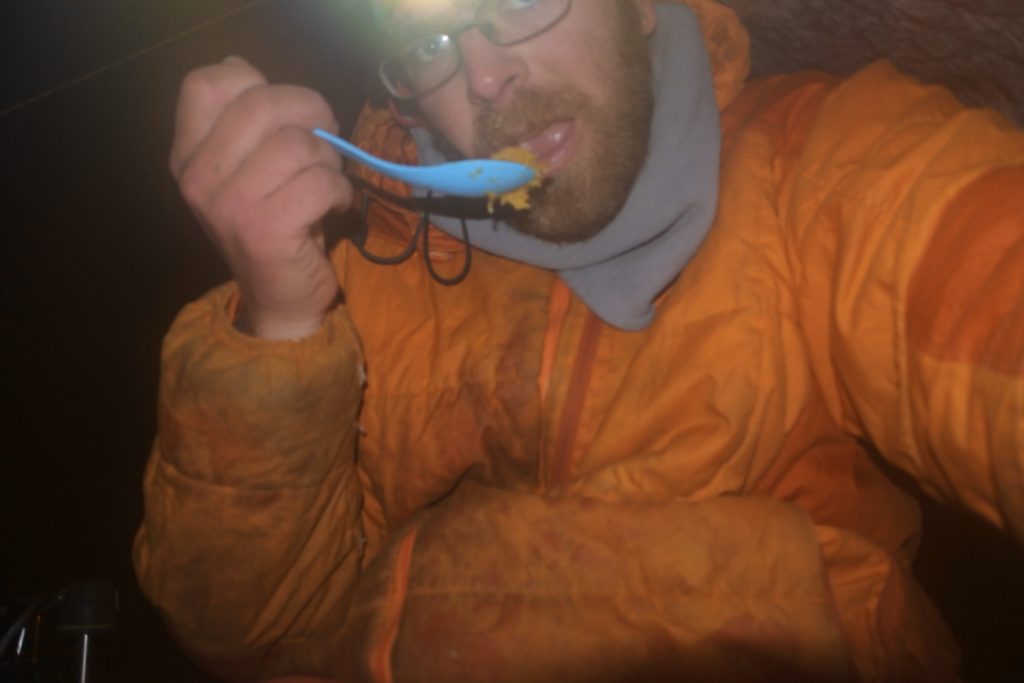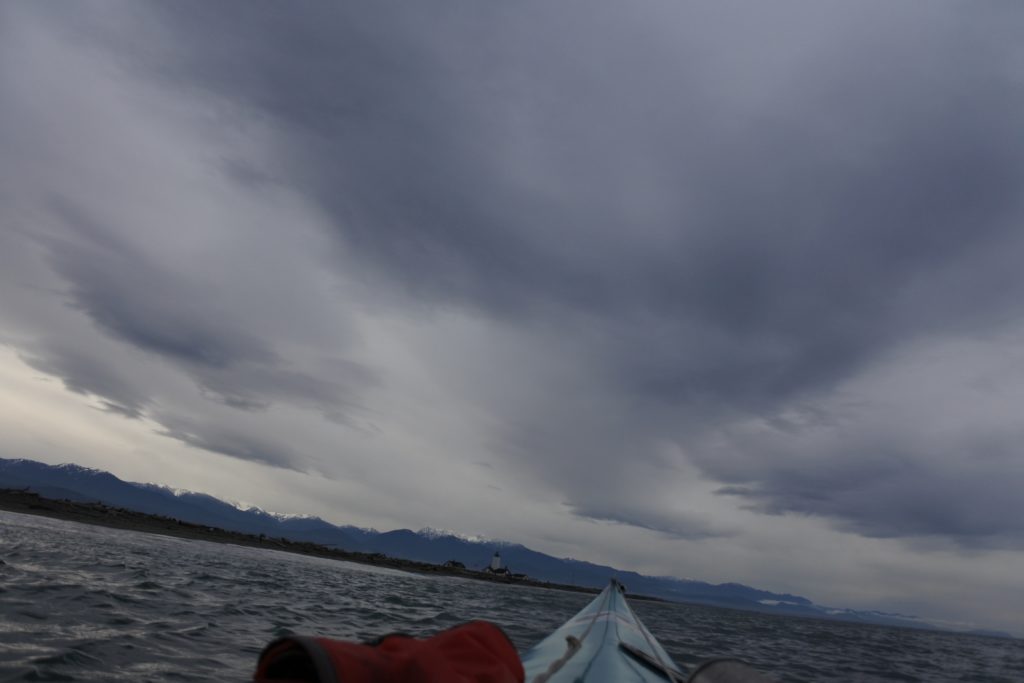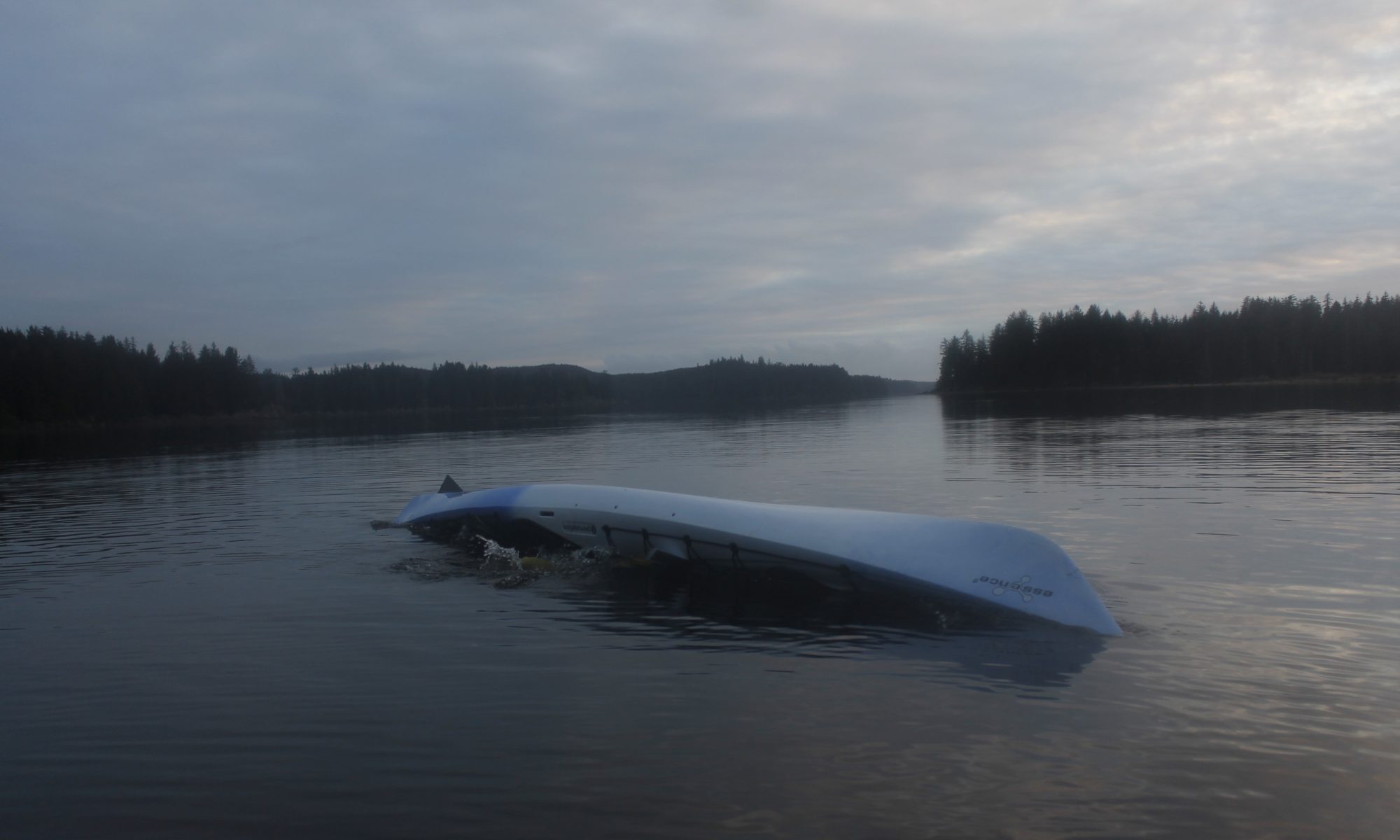The turn of the season had brought change to the waters in the Strait of Juan de Fuca.
On the day after Thanksgiving, the bull kelp had grown thick as my arm. The transparent brown leaves undulated like a mermaid’s hair dozens of feet out. Fully developed, at the end of life, they were not so succulent a snack as they had been in early summer. Age had hardened their flesh. The hollow stipe and bulblike tubes were cloaked in sea lettuce, a tissue-like green algae which provided lighter, saltier fare.
Cold currents had already clearcut the kelp forests so that only the heartiest stalks remained. Soon the others would break off from their holdfasts on the cobble bar dozens of feet below. The snake-like tubes would wash up on the beach the following spring, rigid as PVC pipe, crusted with barnacles.
A pair of Pacific loons floated in Port Angeles Harbor near where I launched my kayak. Their pale color was unfamiliar, but their mournful trill stoked old memories. So did the V-shaped gaggle of geese honking past on the wing and woodsmoke climbing out of chimneys on the hill.
The message should have been clear: Summer was long gone. Gone with it were the days of pleasant paddling and carefree camping. The sun would set around 4:15, but I wouldn’t see it through the heavy clouds (It’s always cloudy or raining now) that hung around the mountain tops. The sunset would chill the air and make the dark water more menacing.

If these were the circumstances of my departure, you might think that it would have affected the kind of plans I’d make for a kayak trip. But I had set the bar high again, my mind set on a months old ambition.
I wanted to paddle east to Port Townsend and back to Port Angeles in three days — about 70 miles of kayaking with a portage over the Dungeness Spit. I would also camp on the bluffs above the spit for two nights.
My other aim was to avoid sleeping in the outhouse like I had on my last trip hiking in the Sol Duc Valley. I wanted to prove to myself that I could launch a trip with creature comforts and a decent quality of life.
Noble goals, Port Townsend and creature comforts, but the 4:15 sunset wasn’t the only thing working against me.
Boat launch to tarp camp
Before I started paddling I spent the morning filling dry bags with warm clothes, wrangling camping equipment and packing food. The goodies going into my bear-proof bin included vegan pumpkin pie that I’d made the day before. The aluminum pie pan didn’t quite fit into the opening, so I folded it into pumpkin taco.
It’d been a good Thanksgiving with friends in town. Now, hitting the water on a three day solo-trip, I felt loneliness. The lifeless gray skies did little to boost spirits. The pie gave me something to look forward to, a dinnertime treat that would brighten my time at camp.
There was a dozen miles of paddling between me and the camp when I hit the water at noon. That closing window between light and dark was on my mind, though I didn’t hurry at first.
I dawdled in the harbor, where the massive industrial infrastructure dwarfed my kayak.
Mega-cranes above the Astoria Bay perched over the docks, waiting to snatch up piles of tree trunks off the docks and load them aboard. Only the mountains were big enough to outrank these massive machines of commerce. The gray-white flanks of Klahhane Ridge rose taller than the radar arrays, snowfields merging into the dull cloud ceiling.
I cut through the pier at the old Rayonier Mill site, where a mature bald eagle sat perched upon a light fixture. Further on, there was Morse Creek, flushed with weeks of rain and snow melt. The easterly swells climbed against the current, peaked and crashed over the surging water.
I surfed a couple waves upstream, and thrashed my way up the current for a couple hundred yards to an eddy by a pedestrian bridge.
I spun myself back into the swift water, leaning downstream with a low brace turn. Paddling a narrow sea kayak with a river current behind me was fast and fun. The scenic detour ended with my bow slapping over the sharp waves at the river mouth.
My paddling became brisker and more business-like after Morse. The shoreline climbed up into inaccessible bluffs. The high tide was right up to the bottom of the cliffs, providing scant opportunity to land. High above, I saw the only patch of blue sky for the day. A swath of golden snow lit up along the Gray Wolf range with purple cloud behind. I paused for a minute, regarding the distant sunlight like holy vision. I also noted how low the light was above the mountains.
It was close to dark by the time I landed on the beach at Dungeness Spit. I still had to hike three quarters of a mile to get to my campsite up on the bluffs. I poured myself a couple of cups of hot chocolate out of my Thermos. If the sunlight wasn’t going to warm my bones anymore, I would have to get heat elsewhere.
I used a bike lock to secure my kayak to a sign post nearby, clipped my gear to my paddle and lifted it up like it was a hobo stick. Thus arrayed, I slouched up the hill toward camp. Darkness was complete by the time I reached the picnic table where I would sleep. I lashed a tarp down over the top of it, rigged another tarp at the front with my kayak paddle — my cooking area and mud room. I peeled my drysuit and damp underclothes, cloaked myself in fleece and polyester batting.
“Let there be fire!” I proclaimed. And my butane stove issued fire. The fire was good — so was the hot pea soup, made rich with coconut oil. I topped my feast with two smushed pumpkin pie slabs.
Warm and flushed with calories, I opted not to crawl immediately into my sleeping bag, but walk around camp instead, coming out to a footpath along the bluffs. Port Angeles lights twinkled in the west, Victoria to the north. The Strait of Juan de Fuca was the dark passage between the islands of light. Restless waters rolled onto the beach below me in their endless surges and retreats.

The east wind
Light flowed back slow into the gray morning.
I took my breakfast, ensconced myself into the drysuit and lifted the gear that I needed back onto my paddle for the trip into Port Townsend. It was a slow start with all the gear wrangling, and the hike back down to the water. After I had re-geared my kayak and pushed it out, it was 11 a.m.. The late start already not so good; added to that, it looked like I needed to change the course I’d planned.
I had intended to carry my kayak over the Dungeness Spit to the calm waters of the harbor on the other side. Alas, the National Wildlife Refuge had put up signs recently forbidding people from crossing over the strip of sand. It was to protect the migrating birds coming through. There was a place on the margins where signage was ambiguous enough that I might have at least maintained plausible deniability carrying my kayak through. Still, the site of birds floating in a lagoon nearby gave me pause. Maybe they would abandon the site if I barged through.

Finally, I decided I would just paddle a couple extra miles and go on the outside of the spit, past New Dungeness Lighthouse.
The spit juts out for over five miles and is in fact the longest sand spit in the United States — the geographical uniqueness is one reason it’s so important to migrating birds. The westerly waves provided an extra push from behind my boat. When the waves come in from that angle, the spit creates a longshore current (little brother to the more infamous riptide phenomenon.) I stayed as close to shore as I could to get the most out of the longshore, though this also meant weaving in and out of the break zone. I looked constantly over my left shoulder as the waves stacked up, and then got the hell out of there before they crashed. When I messed up, the cold frothing water exploded over the top of my kayak, and I had to stick my paddle in a high brace to stay balanced.
The skies had cleared enough that I could see the mountains on the San Juan Islands to the northeast, and the white wall of the Cascade Range right in front of me. It was far more prominent than the way it looked from Port Angeles. The eastern Olympic Mountains towered over me with snowy gables.
The fun and sightseeing wouldn’t last long, though.
First there was an easterly breeze. Tiny little wavelets scurried against the westerly swell. The wind increased, blowing the tops off of the breakers as they came into the beach. I found myself slowing down. By the time that I got to the end of the spit, the biggest waves were coming right at me. I stuck on stubbornly, though when I saw the distant headland at Point Wilson, my hopes of rounding the corner into Puget Sound dimmed. Port Townsend would have to wait another day.
The detour around the spit had left me miles offshore, no way to hide from waves behind shoreline features. I set my trajectory toward the bluffs on Protection Island, near Discovery Bay. It was a few miles distant, but if I could get there, it would mean that I had reached the furthest point that I had paddled west out of Port Townsend. It would have closed a loop and meant that I had paddled all the shoreline between the two town. I guessed that if I could get within a mile of the island, it would live up to its name and give me some protection from the incoming waves.
But the seas were building. I kept fighting for another hour. At 1 p.m., I knew that I had lost, and the only way I could get back to Dungeness by dark was to turn around.
Turning around I had the waves pushing behind me, against an ebb tide leaving Dungeness Bay. The opposition made the waves steep and squirrelly. I found myself leaning on the paddle more than once, taking a few surf rides that skirted the edge between exhilarating and scary.
Surprisingly, once I got back on the outside of the spit, things calmed markedly. The flagpole on the lighthouse indicated that the wind was coming from the southeast now, thus the spit was blocking the biggest waves. It was ironic to find rougher conditions inside the bay than on open sea, but I could hardly complain.
I finally worked up the nerve to take my hands off the paddle and grab lunch. Without the paddle, the muscles in my butt were the most important thing keeping my boat upright. I stayed balanced by clenching left cheek and then right as the waves lapped against my stern and I had lunch. Best of all was the hot water out of my thermos that brought me back to life.

The tough ride home
Back at the campground, I felt a little bummed that Port Townsend hadn’t happened, but made my peace with the fact that conditions had been against me. Even I had started earlier, it seemed unlikely that I could have made it to Port Townsend and back in the face of the east wind.
If the wind kept up, I would have a very fast time getting back to Port Angeles, and might even be able to get in some time noodling around the cliffs or surfing at Morse Creek.
Alas, luck was not on my side.
When I walked down to my kayak and found a strong west wind blowing four-foot breaking waves over the beach.
It was beautiful, foam rolling over foam, gobs of it blowing over driftwood as if this was some nautical-themed rave. Along shore, it stacked into little clusters that quivered like marshmallow peeps.
If I launched out into the mayhem, it was going to be a helluva time, a dangerous time. And I had to be at work tomorrow.
I ended up waiting. When wind raked the beach, I huddled in the trees up in the bluffs nearby. Plenty of daytrippers were going down to the spit to check out the dramatic views. Their entertainment, my predicament. I found a bench inside an educational exhibit — a roof over my head — sipped from my Thermos, and wondered if I’d ever leave the beach. Occasionally, I wondered over to the cliffs and looked at the miles of whitecaps. I squinted at them long and hard. Were the waves softening? Or was it just wishful thinking?
Eventually, I ended up calling my friend Jarrett to ask him if he could check what the weather was going to look like this afternoon.
He said he would find out and call back.
A couple minutes later, my phone rang.
“It’s going to be a shit show,” he said.
By night, the Weather Service called for 40-knot winds around Dungeness with five foot wind waves. 50 miles west, at the entrance of the Strait of Juan de Fuca, the models predicted 25-foot waves.
Jarrett, on his way back from a family visit, was going to be driving near Dungeness in a few hours and offered to pick me up with my boat. I said, I’d probably take him up on it, but would let him know for sure.
I walked over to the cliff; the waves were still tall but had rounded out. I barely felt any wind. If I was going to go for it, I knew I needed to act fast. I texted Jarrett my intentions and hustled back to my boat. There would be about five miles of real exposure where the cliffs would hem me off from the headlands. The other half of my journey, I’d have protection from Ediz Hook, which would take the brunt of the biggest waves. If not for that reassurance, I probably wouldn’t have launched out.
Still, I felt the pressure of a narrow window. Who knew when that wind might pick up again? I scrambled to get all the gear secured into my boat. In my haste, I ended up putting more gear on top than I had before. When it came time to push out into the water, I attempted to scoot myself off the beach into the breakers. I accepted one gentleman’s offer to help push my boat. When the opening came, I paddled hard as I could, taking a breaking wave on my chest. The next wave sent my bow up before I crashed back down the other side. I took a few more strokes and I was free. Yet, I realized that my hasty work rigging my boat up came at a price. The extra weight on my back deck made me extra wobbly. Still, I didn’t dare go ashore and put myself through another launch.
The main wave set was coming at me sideways from the right, while the reflector waves jostled me from the left. I constantly needed to set micro-corrections with my paddle to stabilize the boat.
I was sweating hard beneath the drysuit, but I had done such a rushed job attaching my hydration bladder, that I hadn’t thought that I might want to grab the tube and drink. Well, no water then.
I kept on paddling hard, paranoid at the the thought that the wind was going to come back and jam me over. Neptune’s wrath was not forthcoming, however.
The waves got smaller and smaller the further west I travelled. I set my eyes on the dull line of Ediz Hook with the blinking Coast Guard station tower. It marked the boundary of my salvation. By the time I crossed Morse Creek, it was close to 5 p.m., halfway dark. Still, I was relieved to have entered the protected zone around Port Angeles Harbor.
I switched on a tiny waterproof light atop my deck so that the shipping traffic could see me. Mostly, I just tried to avoid traffic by staying close to shore.
The blast from the MV Coho startled me. The passenger ferry was chugging in from its last run out of Victoria. I lingered near the Port Angeles pier while the boat swept in front of me, waited before crossing the swirling black water churned up by the propellers. I crossed behind the boat, started to relax, only to realize that the bow was coming back at me. The ship was spinning around. I sprinted quickly out of the way.
I was within sight of the ramp at the boat launch I ran my boat up on a floating log that I hadn’t seen in the dark. The bow in the air meant that I had immediately lost much of my stability. I had to paddle backwards very carefully to avoid flipping over.
I got my boat back off and paddled the rest of the way to ramp. I stumbled out onto the concrete. All I needed to do now was unload my boat, throw it on top of my car, strap it down, drive home, peel out my drysuit, shower and cook dinner for myself. I could resort all my gear and clean and launder everything the next day. It all comes out to more hours than the time that I’d actually spent on the water, not getting to Port Townsend.
I couldn’t pretend that kayaking in winter was just the same as summertime when I had happily paddled in warm conditions until 11 p.m. If I got cold now, there was less of a chance that I would shake it off and warm up eventually. The consequences of a capsize were starker and more frightening. East winds are rare in the summer, yet in wintertime, they are common enough in winter. Because of them, my plan to get from Dungeness to Port Townsend and back in a day went from being ambitious to nigh impossible. For all the times that I had been on the water this season, I had to remember that I was only there at the good graces of Mother Nature; there was only so much that I could do to defy her will.
At least I had more pumpkin pie waiting for me in the fridge. Bed would be a welcome place to camp for the night.
